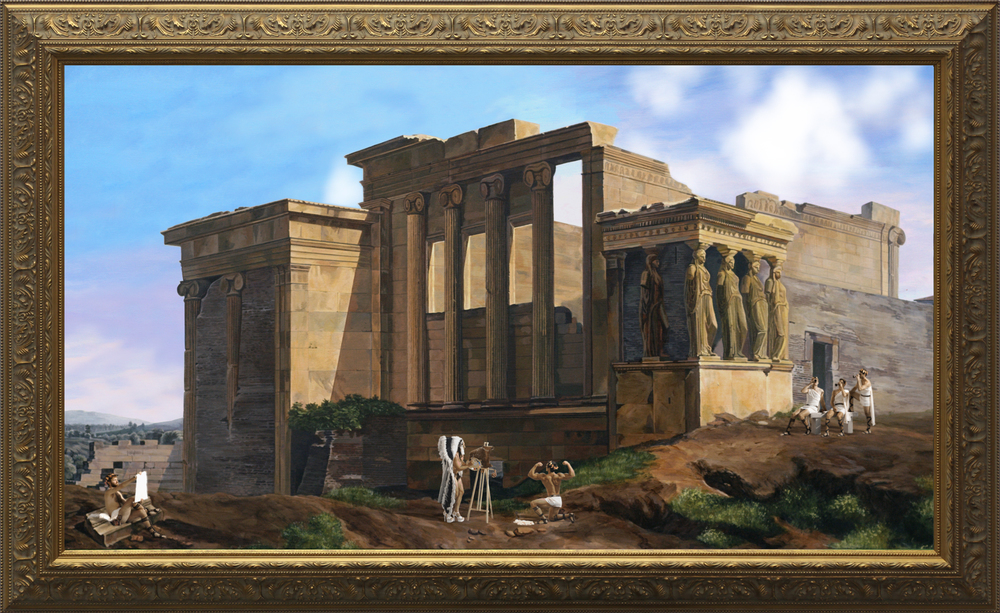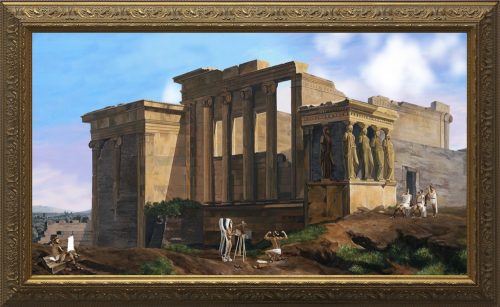A Must-See Exhibit at Taos’ Harwood Museum of Art

By Lenore Macdonald
Taos’ Harwood Museum of Art has a most fascinating exhibit on display now through February 23, 2022: Remote Possibilities: Digital Landscapes from the Thoma Foundation. Concurrently exhibited with Remote Possibilities is Gus Foster’s panoramic photography. Both exhibitions investigate contemporary artists’ use of digital and analog technologies in their representation of both natural and cultural landscapes and the passage of time. They are well worth a visit.
“These artists are at the forefront of using technology to represent nature from a diverse set of perspectives,” said Nicole Dial-Kay, Curator of Exhibitions and Collections for the Harwood Museum. “Remote Possibilities is comprised of primarily two-dimensional works that have been altered using computer technology and aftereffects.”
“Gus Foster is on the other end of the spectrum. Before there were these digital possibilities, he was using analog technology, some of which he created. This conversation of humans and their relationship to nature and whether or not they can replicate nature or represent nature is a very old conversation and ties into ideas of the sublime and truth and representation.”
Remote Possibilities: Digital Landscapes from the Thoma Foundation Collection brings together six of the world’s foremost contemporary digital and media artists who engage the tradition of landscape art: John Gerrard, Kent Monkman, Bruce Nauman, Jennifer Steinkamp, Leo Villareal, and Marina Zurkow. All works in this exhibition are from the collection of the Carl & Marilynn Thoma Art Foundation, a grantmaking and art-collecting organization headquartered in Santa Fe, New Mexico. The Thoma Foundation’s mission recognizes the power of the arts to challenge and shift perceptions, spark creativity and connect people across cultures.

Steinkamp, Jennifer. Bouquet 1, 2013. Generative custom software animation (color, silent), computer, projector. ©Jennifer Steinkamp, courtesy of the Carl & Marilynn Thoma Art Foundation, photo by Joseph Rynkiewicz.
What is the Thoma Foundation
The Thoma Foundation lends and exhibits artworks from its collection to support pivotal initiatives in the arts and support innovative individuals. Founded by Thomas in 2014 to practice their belief that “the arts play a seminal role in society” they established this “arts-specific foundation allow[ing artists] to be secure in the knowledge that their passion in this area would be sustained for decades to come.” www.thomafoundation.org
A portion of the Thoma Foundation’s collection is dedicated to digital and electronic art. Comprising over 300 artworks in this category, the collection encompasses historic computer artworks from the 1960s through 2020. Id.
The Foundation’s philanthropic reach extends beyond the art world to strengthen community, leadership, and education initiatives in under-resourced and rural areas, like Taos and Taos County. “From 2015 to 2020, the Foundation has lent more than 1,000 works of art to over 115 exhibitions across the globe. In addition, the Foundation has made over 65 grants to nonprofit organizations, awarded funding to 21 individuals for scholarly research, and hosted 26 exhibitions at its spaces. The Foundation’s collection numbers more than 1,400 works of art and continues to grow.” Id.
Remote Possibilities: Art in the Digital Age Meets Nature
Jason Foumberg, Curator of Digital Art for the Thoma Foundation notes that the Harwood’s exhibition illustrates that digital and media artists work with new technology while addressing eternally relevant artistic themes. “Picasso said that when he needed inspiration, he would draw a leaf. He would look to nature. I think a lot of people wouldn’t assume that to be true for digital and media artists because they are on their computers all day. Well, not true. These artists also are looking to nature for inspiration and guidance in life.”
The artworks highlighted in Remote Possibilities are temporal and unfolding pieces. Bruce Nauman’s Setting a Good Corner (Allegory and Metaphor) is a video of the artist installing a fence post for a gate on his Las Madres Ranch in Galisteo, New Mexico played on a 27” box television set. The piece lasts for one hour, but the artist does not intend for it to be watched from beginning to end.
“This is time-based art, but it’s not a movie,” explains Foumberg. “You can experience a time-based piece without feeling like you missed something, though the longer you stay the more you see, as with any artwork, because it does continue to reveal itself.”
Kent Monkman, a Cree interdisciplinary visual artist, plays with additional concepts of time by bending the lens of history. In his video painting The Symposium, Monkman recreates an 1805 painting of the Acropolis, Athens by French artist Lancelot-Théodore, Comte de Turpin de Crissé. In this scene, Monkman places an artist wearing a full headdress who paints at an easel while Greek figures look on sipping wine. Jennifer Steinkamp’s Bouquet 1 is a mural-sized digital projection that plays with seasonal time. Through the use of three-dimensional animation software, the piece combines flowering tree branches from different seasons into an impossible arrangement. The resulting bouquet moves slowly as if in a wind.

Monkman, Kent. The Symposium, 2015. Generative custom software animation (color, silent), monitor, media player, custom frame, 3 minutes, 24 seconds. ©Kent Monkman, courtesy of the Carl & Marilynn Thoma Art Foundation, photo by Kent Monkman.
We were mesmerized by Remote Possibilities, as were others viewing it on an October afternoon. One viewer was so moved by Steinkamp’s Bouquet 1 that she completely lost herself in the piece, practicing yoga and dancing. When she turned and saw us, she had the most beautiful expression of joy and peace–and apologized. We asked her to keep at it—that is what art, inspiration, and the creative process are all about.
Gus Foster’s Panoramic Photographs of Northern New Mexico
The themes of landscape and time are also reflected in the analog work of panoramic photographer Gus Foster. The Harwood’s pairing of Remote Possibilities with a concurrent exhibit, Gus Foster: Panoramic Photographs of Northern New Mexico, is intended to create a dialogue around the concepts of nature and ephemerality as represented by artists across the arc of history.

Gus Foster, Sunset, Moonrise, Highline Ridge, Taos County, New Mexico, 1980, 403°. Courtesy of the artist
Gus Foster is a renowned panoramic photographer known for his sweeping depictions of mountaintops. After graduating from Yale University in 1963 with a bachelor’s in art history, Foster worked at the Minneapolis Institute of Arts as the curator of prints and drawings for ten years. In 1972, he moved to Los Angeles to establish his own photographic art studio. He was subsequently enticed by his friend, the artist Larry Bell, to move to Taos and refurbish an old building near the Harwood where the two artists have had their studios since the mid-1970s.
Prior to beginning his work in panoramic photography, Foster made movies in Los Angeles about the passage of time by shooting footage from the passenger’s point of view from the window of a moving vehicle on a stretch of highway.
“I’d go 60 miles in 60 minutes and make a continuous film of what the passenger was seeing out the window. It was effectively like a very long landscape, a 60-mile long landscape,” Foster explained.
This fascination with long, narrow landscapes that addressed the passage of time led Foster to develop an interest in panoramic photography. His work took another turn in 1980 when a mountain-climbing friend invited Foster to climb a 14,000-foot peak in Colorado’s Rocky Mountains.
“It just changed my life,” Foster reminisced. “When you get to the summit you have this uninterrupted view all the way around you. For me, that really was the perfect panoramic view. You can see a hundred miles in any direction on a good day.
Foster went on to photograph many summits in the Rocky Mountains, and scenes of natural and cultural settings. The Harwood’s show includes Foster’s photographs of mountains, wilderness, food, and the urban landscape. Foster prints his large-scale photographs as narrow strips ranging from two feet to 16 feet in length. Each photograph renders a circular spatial view as well as the temporal fingerprint of the time taken to shoot the picture.

Gus Foster, Taos Pueblo Christmas Eve, New Mexico, 198e, 315°. Courtesy of the artist
“My images are all more than 360 degrees,” Foster explains. “In most of them, there’s an image on the extreme left side and the extreme right side that will be the same. The only way you get that is to move in a circle. Part of that is proof that they are full panoramas, but the appealing thing to me is that the photograph also has the possibility of recording the passage of time. Say you saw a hawk sitting in the top of a tree on the left-hand side, by the time you get back to it 45 seconds later, it’s gone, or something has changed – the clouds shift, or the sun has come out – time has passed.”
Foster’s emphasis on temporality is also found in the subjects he chooses. Christmas Eve, Taos Pueblo is a chiaroscuro study in light and dark with shadowed groups of people standing around the flames of bonfires in various stages of burning at this annual nighttime occasion. In Sunset Moonrise Highline Ridge Foster has photographed a moment of shifting spheres of light as daytime gives way to darkness on the mountaintops and the moon reflects the setting sun. Northern New Mexico is the center point of the artist’s journey, and Gus Foster: Panoramic Photographs of Northern New Mexico follows the horizon line of time from past to present, from the beginning to now.
If your travels take you to Taos or Santa Fe, Durango or Southern Colorado, head over to The Harwood and experience these two exhibits. You, too, may lose yourself in the art.
Helpful links:
The Harwood Museum is located at 238 Ledoux Street, Taos. www.harwoodmuseum.org
Read more about the Marilyn & Carl Thoma Foundation here: https://thomafoundation.org/ If your travels take you to Santa Fe, be sure to visit the Thoma Foundation Art Vault Santa Fe at 540 S. Guadalupe St. in the Santa Fe Railyard Arts District. https://artvault.thomafoundation.org
© 2021 Lenore Macdonald. All rights reserved.







